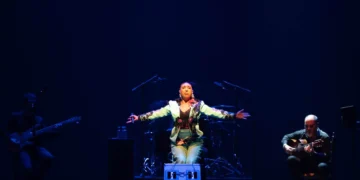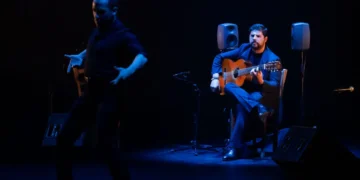|
|
||||
|
SPECIAL BIENAL DE FLAMENCO DE SEVILLA 2008 Text: Estela Zatania Director: José Antonio. Main dancers: Ana Moya, Elena Algado, Miguel A. Corbacho. First dancers: Cristina Gómez, Esther Jurado, Jesús Carmona, Sergio García. Soloists: Aloña Alonso, Esther Esteban, Jéssica de Diego, Tamara López, José Manuel Benítez, Francis Núñez, Isaac Tovar. Cante: Isabel Soto, Manuel Palacín, Momi de Cádiz. Guitar: Diego Losada, Enrique Bermúdez, Jonathan Bermúdez. Percussion: Samuel Flores. Piano: Juan Álvarez, Juan José Sánchez. Guest artist: Esperanza Fernández. Musical interpretation: Chano Domínguez and group. Marina Albero (keyboard), Jordi Bonell (guitar), Guillermo McGill (drums), Mario Rossy (bass). When forty thousand people came to Seville to attend Madonna’s concert at the Olympic Stadium, we were at the Teatro de la Maestranza for something less mediatic, but nevertheless a noteworthy event for theater flamenco. Originally created to commemorate the centennial of the birth of Salvador Dali, this reinterpretation of the classic work “Café de Chinitas” debuted in 2004 with the Centro Andaluz de Danza. The original version, by legendary dancer Argentinita, was first performed in 1943 in the United States. Based on the famous arrangements of Federico García Lorca of eight popular folkloric songs, and with original backdrops by Dalí, the work is a magnificent time capsule that sixty-five years after its creation, not only reproduces the post-modern aesthetic of the era, but maintains its absolute artistic relevance; with the helping hand of José Antonio, director of the Ballet Nacional de España and the person responsible for the work, the genius of Dalí and Lorca crosses cultural, geographic and generational frontiers.
Surrealism that reaches the bizarre is the basic aesthetic of a show full of references to love, death, sex, the interior life of all humans. Cyclists wearing huge loaves of bread for hats, bugs that race around three enormous eyeballs hung from the ceiling, half-melted clocks that float like dainty preservatives, the odd drawers that slowly open and close by themselves, the wriggling maggots that appear at the end of a conventional soleá dance…. The work is full of unsettling visual elements, courtesy of Dalí, that annul any possible hint of business-as-usual. And all the while, the seemingly innocent melodies we’ve all known since childhood: the Zorongo, Los Cuatro Muleros, Anda Jaleo, the Tarara or Café de Chinitas itself, among others, sprinkled between such basic forms as soleá and siguiriya. Thanks to the wise direction of José Antonio, this complicated undertaking achieves the difficult balance between dance and theater that other shows have such trouble hitting upon. You’re watching a dance show and hearing music, and a wealth of theatrical elements enriches the experience giving depth of dimension without straying far from flamenco.
No single member of the group is particularly noteworthy, and chances are, any one of them would pass unnoticed in any company. With one important exception. Esperanza Fernández, a cantaora who never caught my attention, here is magnificent in every way. She gives the human touch to a work that is almost frightening. With her plain direct voice she comes to rescue you at opportune moments, and without her the show would lack coherence and soul. In addition to singing, she is a wonderful actress, simultaneously playing the part of angel, spirit, narrator and accomplice to the action. Also outstanding, in a work full of outstanding moments, is the scene of La Tarara with the cross-dressing cabaret performer, a part played by José Antonio himself. His crazily cheap dance with a small fan, and Esperanza’s Marilyn Monroe gestures that mock him, are an exquisite touch of frivolous humor that abruptly ends with the sound of drums and the cruel persecution of the cabaret performer. Also present is the pathetic figure of Lorca in his white suit, hat and bowtie. A sort of fiesta finale where the entire company dances sevillanas, is the closing moment of this master work, a classic of Spain’s cultural heritage. |
Descubre más desde Revista DeFlamenco.com
Suscríbete y recibe las últimas entradas en tu correo electrónico.


 XV BIENAL DE FLAMENCO DE SEVILLA
XV BIENAL DE FLAMENCO DE SEVILLA 


























